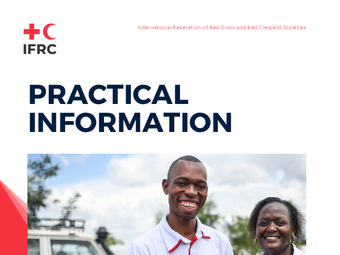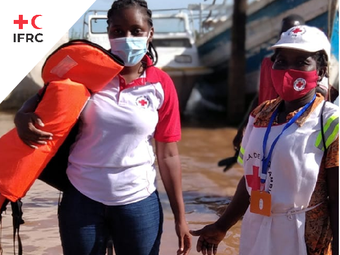Forecast-based Action by the DREF: IFRC’s Disaster Response Emergency Fund
The Anticipatory Pillar of the International Federation of Red Cross and Red Crescent Societies (IFRC) Disaster Response Emergency Fund (DREF) is dedicated funding to support anticipatory action via three financing mechanism: (1) Early Action Protocols (EAPs); (2) Simplified Early Action Protocols; and (3) DREF for imminent events.
Through the Anticipatory Pillar, financial resources are agreed in advance and tied to predefined thresholds (triggers). Once a trigger is reached, these resources are released, enabling the implementation of the agreed actions to prevent or mitigate negative humanitarian impacts on vulnerable populations.
National Red Cross Red Crescent Societies can access up to 500,000 Swiss francs for an EAP. Each EAP has a lifespan of five years and include three components:
- the prepositioning of stock essential to enable early actions
- readiness activities that ensure the National Society is prepared and on standby to respond
- pre-agreed early action activities designed to save lives and livelihoods ahead of a forecast hazard.
In June 2022, the IFRC introduced the Simplified Early Action Protocol, a lighter approach to anticipatory action planning. Under this funding mechanism, any National Society can access up to 200,000 Swiss francs over a lifespan of two years. Like the EAP, this includes funding for prepositioning of stock, annual readiness activities and early action activities.
If a National Society has not developed an EAP, or a Simplified EAP, it can access DREF funding for an imminent event when it is clear that the event is on the horizon. Under an imminent DREF, readiness activities are eligible as well as procurement of the stock required – in advance of early action activities – but a DREF operation typically is only a max of six months, so readiness activities are not annual (unlike an EAP or a Simplified EAP). However, unlike the other modalities, the funding is not preapproved in advance; the National Society will need to prepare a plan and budget before funding is realized and the time allowed for readiness and prepositioning are shorter – one month for a sudden-onset hazard and up to four months in advance of a slow onset hazard.
EAPs go through a technical review by IFRC sectoral experts and are approved by the Validation Committee, which comprises members from Partner National Societies and the Red Cross Red Crescent Climate Centre. This review is undertaken using standardized quality criteria.
Early Action Protocol Quality Criteria
Simplified Early Action Protocol Quality Criteria
For further details on anticipatory action at IFRC, click here.
Further information
DREF Anticipatory Pillar
Organization:
International Federation of Red Cross and Red Crescent Societies
Launched:
May 2018
Geographical scope:
Worldwide
Who can apply:
National Red Cross and Red Crescent Societies
Types of hazard:
Weather- and non-weather-related hazards
FbA by the DREF in numbers
FbA by the DREF provides funding for National Red Cross Red Crescent Societies to implement their approved early actions once a pre-defined trigger is met.
Photo by Mongolia Red Cross Society, 2020



